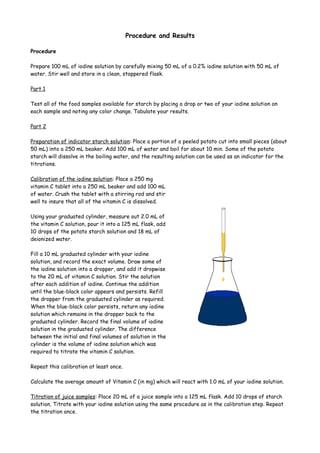Procedure and results vitamin c
- 1. Procedure and Results Procedure Prepare 100 mL of iodine solution by carefully mixing 50 mL of a 0.2% iodine solution with 50 mL of water. Stir well and store in a clean, stoppered flask. Part 1 Test all of the food samples available for starch by placing a drop or two of your iodine solution on each sample and noting any color change. Tabulate your results. Part 2 Preparation of indicator starch solution: Place a portion of a peeled potato cut into small pieces (about 50 mL) into a 250 mL beaker. Add 100 mL of water and boil for about 10 min. Some of the potato starch will dissolve in the boiling water, and the resulting solution can be used as an indicator for the titrations. Calibration of the iodine solution: Place a 250 mg vitamin C tablet into a 250 mL beaker and add 100 mL of water. Crush the tablet with a stirring rod and stir well to insure that all of the vitamin C is dissolved. Using your graduated cylinder, measure out 2.0 mL of the vitamin C solution, pour it into a 125 mL flask, add 10 drops of the potato starch solution and 18 mL of deionized water. Fill a 10 mL graduated cylinder with your iodine solution, and record the exact volume. Draw some of the iodine solution into a dropper, and add it dropwise to the 20 mL of vitamin C solution. Stir the solution after each addition of iodine. Continue the addition until the blue-black color appears and persists. Refill the dropper from the graduated cylinder as required. When the blue-black color persists, return any iodine solution which remains in the dropper back to the graduated cylinder. Record the final volume of iodine solution in the graduated cylinder. The difference between the initial and final volumes of solution in the cylinder is the volume of iodine solution which was required to titrate the vitamin C solution. Repeat this calibration at least once. Calculate the average amount of Vitamin C (in mg) which will react with 1.0 mL of your iodine solution. Titration of juice samples: Place 20 mL of a juice sample into a 125 mL flask. Add 10 drops of starch solution. Titrate with your iodine solution using the same procedure as in the calibration step. Repeat the titration once.
- 2. Analyze at least two juices, and for each juice analyzed, calculate the mg of Vitamin C per 20 mL of juice. Results Part 1 All observations indicating the presence or absence of starch should be clearly tabulated. Part 2 For each titration, record the initial and final volume of iodine solution in the graduated cylinder, and the volume used in the titration. Show all of your calculations which lead to the average number of milligrams of Vitamin C in each sample.

